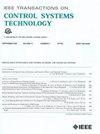基于旋转支撑超平面控制屏障函数的椭球刚体避碰
IF 3.9
2区 计算机科学
Q1 AUTOMATION & CONTROL SYSTEMS
引用次数: 0
摘要
本文提出了一种椭球体的避碰方法,该方法利用了由支撑超平面设计的控制屏障函数(CBF)。我们在特殊的欧几里得群${SE}(2)$和${SE}(3)$中表述问题,其中运动学被描述为刚体运动(RBM)。利用刚体的支撑超平面到另一个刚体的有符号距离,考虑两个椭球刚体分离的条件。虽然这个带符号距离的正值意味着两个刚体不会发生碰撞,但一个天真设计的支撑超平面产生的值比实际距离要小。为了避免这种保守的评估,旋转支撑超平面,使支撑超平面到另一个刚体的带符号距离最大化。我们证明了该优化问题的最大值等于两个椭球刚体之间的实际距离,从而消除了过度的保守性。当支持的超平面通过基于梯度的输入旋转时,我们利用这个带符号的距离作为CBF来防止碰撞。设计的CBF被集成到一个二次规划(QP)问题中,其中每个刚体以分布式方式计算其无碰撞输入,给定刚体之间的通信。我们举例说明,我们的方法可以推广到其他的运动学模型。仿真结果验证了该方法的有效性。本文章由计算机程序翻译,如有差异,请以英文原文为准。
Collision Avoidance for Ellipsoidal Rigid Bodies With Control Barrier Functions Designed From Rotating Supporting Hyperplanes
This article proposes a collision avoidance method for ellipsoidal rigid bodies that utilizes a control barrier function (CBF) designed from a supporting hyperplane. We formulate the problem in the special Euclidean groups
${SE}(2)$
and
${SE}(3)$
, where the kinematics are described as rigid body motion (RBM). We consider the condition for separating two ellipsoidal rigid bodies by employing a signed distance from a supporting hyperplane of a rigid body to the other rigid body. Although a positive value of this signed distance implies that the two rigid bodies are collision-free, a naively designed supporting hyperplane yields a smaller value than the actual distance. To avoid such a conservative evaluation, the supporting hyperplane is rotated so that the signed distance from the supporting hyperplane to the other rigid body is maximized. We prove that the maximum value of this optimization problem is equal to the actual distance between two ellipsoidal rigid bodies, hence eliminating excessive conservativeness. We leverage this signed distance as a CBF to prevent collision while the supporting hyperplane is rotated via a gradient-based input. The designed CBF is integrated into a quadratic programming (QP) problem, where each rigid body calculates its collision-free input in a distributed manner, given communication among rigid bodies. We exemplify that our method can be extended to other kinematic models. The proposed method is demonstrated through simulation results.
求助全文
通过发布文献求助,成功后即可免费获取论文全文。
去求助
来源期刊

IEEE Transactions on Control Systems Technology
工程技术-工程:电子与电气
CiteScore
10.70
自引率
2.10%
发文量
218
审稿时长
6.7 months
期刊介绍:
The IEEE Transactions on Control Systems Technology publishes high quality technical papers on technological advances in control engineering. The word technology is from the Greek technologia. The modern meaning is a scientific method to achieve a practical purpose. Control Systems Technology includes all aspects of control engineering needed to implement practical control systems, from analysis and design, through simulation and hardware. A primary purpose of the IEEE Transactions on Control Systems Technology is to have an archival publication which will bridge the gap between theory and practice. Papers are published in the IEEE Transactions on Control System Technology which disclose significant new knowledge, exploratory developments, or practical applications in all aspects of technology needed to implement control systems, from analysis and design through simulation, and hardware.
 求助内容:
求助内容: 应助结果提醒方式:
应助结果提醒方式:


